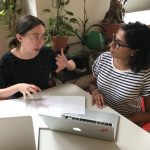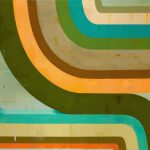Conversations | Meet Angélica Dass, Brazilian Artist and Activist
“I believe that art and photography can be a tool to empower disadvantaged communities, especially women, because those are the kind of voices that sometimes are not heard.”
Angélica Dass is an award-winning photographer living in Madrid. Originally from Rio de Janeiro, she is very aware of how small differences in skin tone can create misconceptions and stereotypes about race. She is the creator of the acclaimed Humanae project, a collection of portraits that reveals the beauty of the diversity of skin colors. This initiative has traveled to more than 30 countries on six continents, from the World Economic Forum in Davos to the pages of National Geographic, to promote dialogue that challenges the way we think about skin color and ethnic identity. Today, her TED Talk exceeds two million views.
NYFA: You say you are an “activator more than activist.” Can you talk more about that?
Angélica Dass: For me, the role of an artist is to start a conversation. Because, in the end, I really believe that I can’t change the world; the only person that I can change is myself. But if we talk more about these issues that you feel are not right outside (and as an artist you are able to put these inflections in the making of art), maybe other people can decide that they want to change themselves. So that is why I see the role of the artist as someone that uses something (photography, archive, images, etc.) to generate empathy and propose a discussion that can have a direct impact in our collective future.
‘Yo lo que digo es que yo vengo enciendo la foguera y salgo corriendo, en general eso es lo que pasa.’ What I tell people is that I arrive, light the fire, and run away. In general, that’s what happens.
NYFA: Is there a particular moment in your life that had a major impact on your career?
AD: There was a time in my life when I was working in fashion, and it was while making street style photos that I realized that I didn’t see myself in the images I was producing. Also, the moment I went back to school to start a Master’s Program in photography and created Humanae. It made me think about why I wanted to continue to work with photography, the reason for it, and why I have the camera in my hands. I decided then that I wanted to use photography as a tool that is focused on social issues; that is focused not just on creating beautiful images, but on the purpose behind those images. This was one moment that was truly important to me. I had a lot of teachers and friends that in some way guided me when I was trying to create something that I felt was not common.
I don’t have a gallery, I don’t sell photos. I sell engagement, a sense of belonging … In some way, I was able to convince institutions that they have to pay me for the experience. That what happens is something that impacts the community and that we’ll be creating it together.

NYFA: Your work transcends museums and classrooms. Can you tell us about your project Yo Soy Somos (I Am, We Are)?
AD: Yo Soy Somos is a newspaper and an exhibition made with the purpose of sharing a new narrative about immigrant women. I specifically used newspapers because it is from newspapers that we receive lies and stereotypes about them. So, in a way, I’m using that same platform to create another narrative. Marta, Alima, and Gladys are some of the protagonists. They all have names, but they share stories that could be mine, yours, or ours. I believe that art and photography can be a tool to empower disadvantaged communities, especially women, because those are the kind of voices that sometimes are not heard.
NYFA: What was the starting point for that project?
AD: Yo Soy Somos is a project that was made specifically for the city of Madrid. It was a collaboration with the city government and with a non-governmental organization (NGO). I’ve organized many different collaborations; one of them is called Alianza Por La Solidaridad. In these cases, we connected with different associations that have female leaders, and they are all immigrants. The idea is to show another narrative about immigration in Madrid, using an approach that takes them away from the prejudices and stereotypes to which they are usually subjected to. Through I Am, We Are, we get to know those women better; women who do not normally appear in the media or in public spaces, but that have been living in our society for many years and contributing to initiatives of change and social transformation.
NYFA: What does social media/internet mean to your work?
AD: I believe social media is a very important tool. It is the way that we can find partners, connections, mirrors in different parts of the planet. It opens several possibilities for connections between human beings. This is the main power of social media and social network; they are able to connect me with someone that is on the other side of the planet and you never know how many things in common you’ll have.
NYFA: Could you give some advice to artists working today?
AD: I always have the same advice for my students and it is: “Be honest!” It looks like something very basic, but really, be honest! You know it when you are doing something that is not right, not coherent, in a work of art. This is something that I miss in the art world, sometimes. Maybe we can be too critical and too political in a piece, but the truth is that we are just showing one side. My other advice is to give back. Give back to the community that you’re working with and try to be coherent and respectful of them.
Learn more about Angélica Dass.
This interview is part of the ConEdison Immigrant Artist Program Newsletter #107. Subscribe to this free monthly e-mail for artist’s features, opportunities, and events.
– Interview Conducted by Alicia Ehni, Program Officer at NYFA Learning
Images: Yo Soy Somos, Courtesy of Angélica Dass






